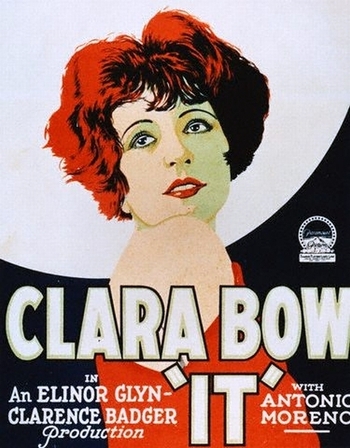
Elinor Glyn was one of the most popular authors before the Crash. Hugely, exceedingly, inordinately popular. Women devoured her books like chocolate. With powerful, modern, and most importantly independent female protagonists in formulaic plots with just a touch of eroticism and a happy ending it's not hard to see why.
Madame Glyn (as she preferred to be called) was also one of the first novelists to see the potential of aligning with the film colony in Hollywood. Anita Loos once quipped "If Hollywood hadn't existed, Elinor Glyn would have had to invent it". Hollywood was a way to further Madame Glyn's method of self-promotion and boosted sales of her books when they were adapted into films (including the recently rediscovered Beyond the Rocks with Swanson and Valentino). Given how much time she spent at San Simeon and Pickfair, she had enormous clout as to deciding whether a person was really a star or not.
However, her lasting legacy is not for her numerous novels or her personal fame. She created the term "It" for a person that had that extra special something about them (a combination of charisma and sex appeal) and in a major publicity stunt, deemed Clara Bow to be the one and only It Girl and so cemented both of their legacies.
The 1927 novel bares almost no resemblance to the film, but who cares since it is the most widely available Clara Bow film and is just over an hour and has some marvellous costumes. The novel It tells the story of Ava Cleveland, one of the most famous of the New York aristocracy. Ava and her brother Larry are broke but have too much pride (or stupidity) to ask for help. Larry is a nogoodnik bounder, who's addicted to opium, gambling and his Chinese girlfriend Lo Lu, who is also his dealer. Larry is continuously asking his sister for money and because Ava is devoted to her brother and knows nothing about his personal failings, because she is inherently good, will go to great lengths in order to supply it, even failing to pay her enormous dress bill to do so. And so she asks the wealthy, older businessman John Gaunt for a job. John Gaunt is obsessed with "conquering" Ava and gaining power over her and so he creates a job for her in his New York office and one for Larry in San Francisco and bides his time until Larry gets caught and asks for a large sum in order to keep out of jail and Ava will come to him for help. John Gaunt is from the lower class and worked his way up, but he likes to put on airs -going to Savile Row and having the finest and largest apartment in the city. Naturally the jewel in his crown would be to have a wife from one of New York's oldest families. Both John and Ava have "It" and are naturally drawn to each other for that reason and when two "Its" meet they naturally will want to produce a "That". But Ava resists John for the usual reasons and John finds it harder to contain his emotions and so he hires a French decorator to make up a suite for the future Mrs. Gaunt to distract himself until he gets the bright idea to stalk Ava and have his servant spy on her. But everything turns out right in the end with an unusual proposal.
I was surprised at how quickly I read the novel, but I know why. Except for the difference in language, taboos, social conventions and the casual racism, it is the exact same story that you will find if you were to wander into your favourite bookstore and pick up the first Chick Lit book you find. Replace Larry the drug addict with the over barring mother, Ava's past due dress bill with credit card debt, her aristocratic background with a degree from a posh university and being a party girl, and John Gaunt's busy businessman, obsessed with power with... actually he'd probably just stay the same and you have the exact same story and characters that populate today's popular, non literary novels. And they ending would remain the exact same, but with room for a sequel. But at least if you read It, you'll have bragging rights and could read it openly on the bus.
Despite it's popularity, It has not been republished since 1927. I couldn't even find a picture of the original dust jacket online. You will probably find a copy at a university library instead of your local branch, if you can't find it online or at the second hand bookstore. But it does make for a fascinating read if you want to understand what was popular in the Twenties.

No comments:
Post a Comment